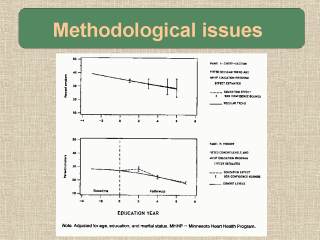|
|
|
|
front |1 |2 |3 |4 |5 |6 |7 |8 |9 |10 |11 |12 |13 |14 |15 |16 |17 |18 |19 |20 |21 |22 |23 |24 |25 |26 |27 |28 |29 |review |
 |
This slide illustrates the
importance of comparison or control groups in the evaluation of the impact of
community based interventions. It shows the effect estimates of the Minnesota
Heart Health Program on smoking prevalence (Am J Public Health 1994;84:1383).
The program effect is depicted by the dotted line and the secular trend by the solid line. Without information on the secular trend one could conclude that the program reduced smoking prevalence because of the negative slope of the smoking prevalence curve in the experimental communities. However, the secular trend in the control communities showed very similar decreases in smoking prevalence and the comparison of the two curves show no significant (clinical, statistical or public health) differences in the smoking prevalence trends between experimental and control communities. |